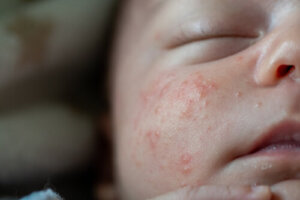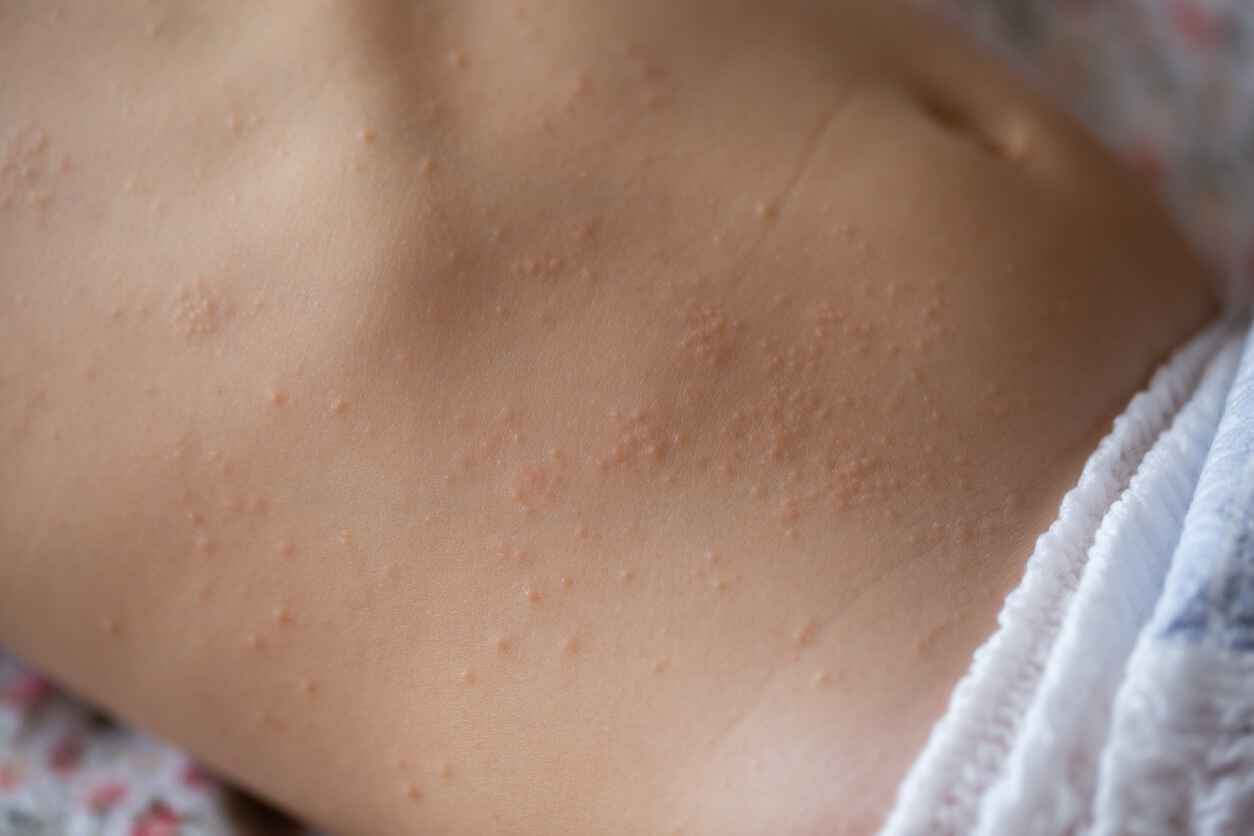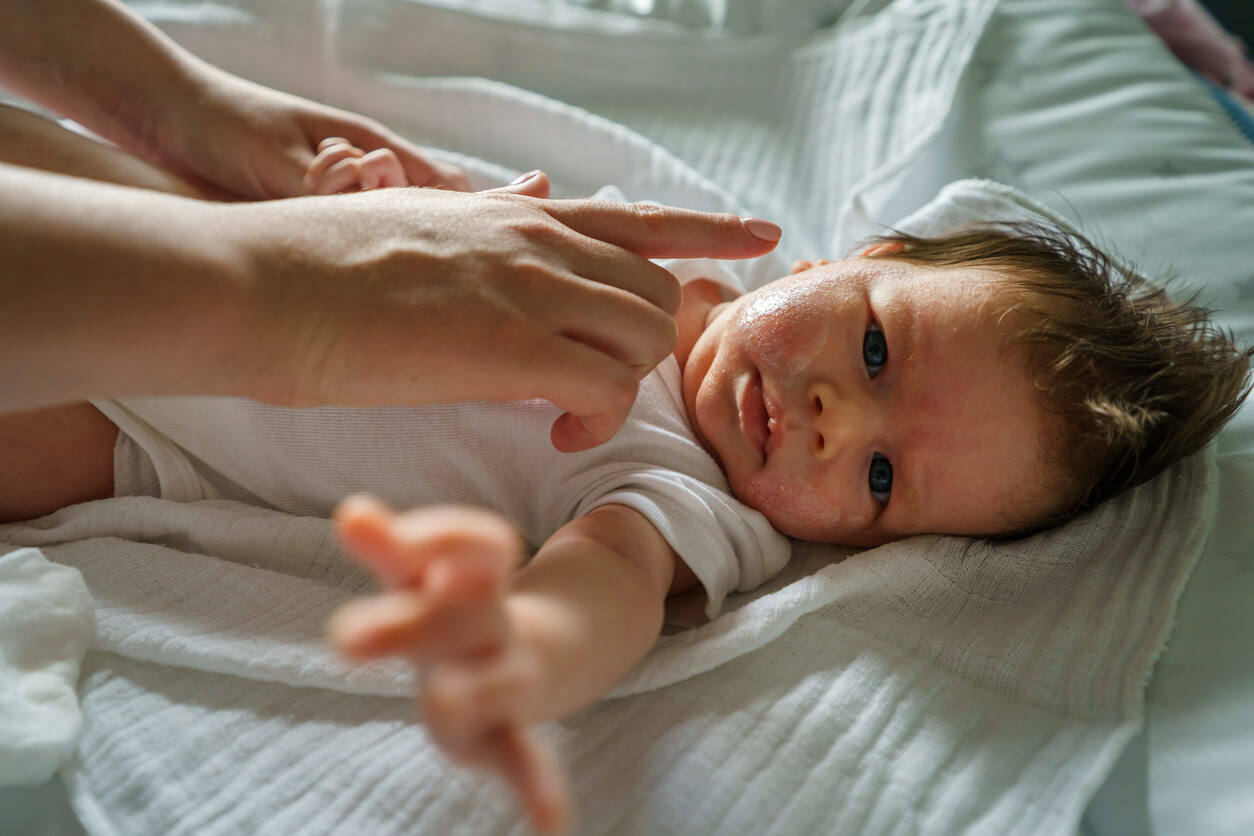Benign Skin Lesions in Infants: Types and Care


Written and verified by the dermatologist Maria del Carmen Hernandez
There are benign lesions on the skin of infants that are usually transient and resolve spontaneously over time. In addition, the skin of newborns isn’t yet fully developed, which makes practicing proper care to try to prevent their appearance essential.
Types of benign lesions on the skin of infants
In most cases, benign lesions on the skin of infants have an evolution limited to the first months of life, without the need for treatment. However, it’s important to recognize them so that parents aren’t worried or anxious. In turn, the conditions can be caused by various factors such as cold, heat, bacteria, allergies, fungi, or prolonged contact with wet diapers. Learn about the most common benign lesions below.
Miliaria
Miliaria is a type of heat rash that occurs in newborn babies due to the blockage of their underdeveloped sweat glands. It appears in the form of tiny red bumps on the regions of the buttocks and back. To prevent them, it’s important not to dress the baby too warmly or in thick diapers and to choose 100% cotton clothing.
You might be interested in: What Are Those Little Red Spots on My Baby’s Skin?

Diaper rash
Diaper rash affects about 50% of infants and accounts for 25% of dermatological consultations in the first year of life. The main manifestations are a red rash on the areas covered by the diaper. For this reason, it’s best to avoid prolonged contact of the skin with feces and urine in order to reduce the humidity of the area. In addition, cloth or adhesive tapes shouldn’t generate too much friction on the skin’s surface.
Cradle cap
Seborrheic dermatitis, also known as cradle cap, usually occurs during the first weeks of life. It’s characterized by white or yellow scales on the oily scalp of the child. While there’s no way to prevent its appearance, once present, it can be removed with the gentle use of almond oil.
Acne neonatorum
The appearance of acne neonatorum is very similar to adolescent acne vulgaris. That is, it presents inflammatory papules, comedones, and pustules on the face. Moreover, it appears during the first weeks of life in 20% of infants due to stimulation of the sebaceous glands. Although it usually disappears on its own in the first months of life, 2% erythromycin creams may be indicated.
Erythema toxicum neonatorum
Erythema toxicum is an inflammatory and benign skin condition. It appears between the first and third day of life as tiny papules on the trunk. There’s no way to prevent it, but it doesn’t require treatment as it’s an asymptomatic condition and resolves spontaneously.
Read also: My Baby Has Reactive Skin
Atopic eczema

This is also known as atopic dermatitis and is the most common skin condition affecting infants, children, and adults. Symptoms usually begin during the first year of life and improve as the child gets older. However, the condition may recur as outbreaks after a few years.
The skin appears red, rough, and dry. In addition, it involves intense itching, especially on the cheeks and in the creases of the legs and arms. Although its development can’t be prevented due to its genetic basis, it’s very important to keep the skin moisturized, wear cotton clothing, and take short baths with warm water (not hot).
Mongolian spot
This is a nevus that’s located in the lumbosacral region and can extend to the buttocks. It’s found at birth and tends to disappear gradually in the first years of life. It can sometimes persist throughout childhood and even into adulthood.
Baby skin care
The skin is a protective barrier that helps prevent the loss of minerals and body fluids, prevents the absorption of toxic substances, and protects against various infections.
Newborn skin is sensitive and delicate, as is the immune system. Therefore, although rashes are common in newborns, fragrances and dyes in clothing, as well as chemicals and detergents, can cause dryness, irritation, rashes, and chafing. Some recommendations for caring for newborn skin include the following:
- Don’t bathe the child too often: Otherwise, the skin’s natural protective oils are removed, leaving it dry and vulnerable.
- Avoid using perfumed cosmetic products: This is because they can cause irritation during the baby’s first months.
- Wash clothes before wearing them for the first time: Choose clothing detergents that don’t contain dyes or fragrances.
Benign baby skin lesions and medical consultation
Fortunately, most benign baby skin lesions occur for a short time and resolve on their own. However, there are cases that may require ointments, creams, or oral medications to resolve the condition. In conclusion, it’s always important to consult your pediatrician if you have any concerns or before starting any treatment not indicated by a specialist.
All cited sources were thoroughly reviewed by our team to ensure their quality, reliability, currency, and validity. The bibliography of this article was considered reliable and of academic or scientific accuracy.
- Benítez Ojeda AB, Méndez MD. Dermatitis del pañal. [Actualizado el 22 de julio de 2021]. En: StatPearls [Internet]. Treasure Island (FL): StatPearls Publishing; 2021 enero-. Disponible en: https://www.ncbi.nlm.nih.gov/books/NBK559067/
- Roques E, Ward R, Mendez MD. Erythema Toxicum. [Updated 2021 Sep 9]. In: StatPearls [Internet]. Treasure Island (FL): StatPearls Publishing; 2021 Jan-. Available from: https://www.ncbi.nlm.nih.gov/books/NBK470222/
- Serna-Tamayo C, Janniger CK, Micali G, Schwartz RA. Neonatal and infantile acne vulgaris: an update. Cutis. 2014 Jul;94(1):13-6. PMID: 25101339.
- Nobles T, Harberger S, Krishnamurthy K. Cradle Cap. 2021 Aug 11. In: StatPearls [Internet]. Treasure Island (FL): StatPearls Publishing; 2021 Jan–. PMID: 30285358.
This text is provided for informational purposes only and does not replace consultation with a professional. If in doubt, consult your specialist.








